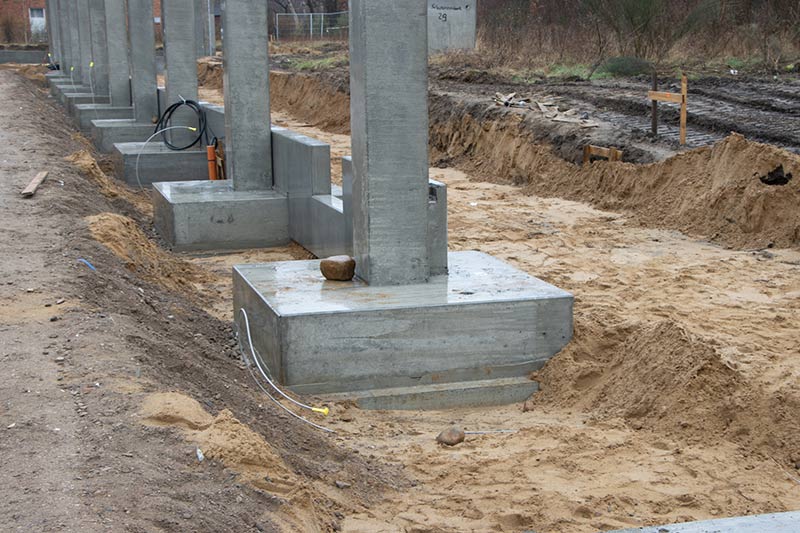Foundations form an integral part of every construction project, transferring the load of the building down into stable soil or rock. The type of foundation that is required for a particular project will vary, taking into account a range of factors, such as the design of the building and its loading requirements, the site access and proximity to neighbouring buildings, ground conditions, budgets and timeframes, and more. In this article, we look at a type of foundation that is commonly used in commercial and industrial warehouse builds – pad foundations.
What Is A Pad Foundation?

Foundations can generally be split into deep foundations and shallow foundations, and for the most part, pad foundations are classed as shallow foundations, although deep pad foundations are feasible, if not necessarily cost-effective. They are typically used in warehouse-type buildings or framed structures, where the pads are used to support columns or structural framework within the superstructure. Pad foundations can also be used to support ground beams.
Pads are typically square or circular in shape, although for some specific circumstances, they can also be rectangular. On the whole, the depth of a concrete pad is between 600mm and 2000mm – if greater depth is required, then pile foundations are generally considered to be more cost-effective. Pad foundations are only suitable when the ground has an adequate load bearing capacity at shallow depths.
Pads are typically square or circular in shape, although for some specific circumstances, they can also be rectangular. On the whole, the depth of a concrete pad foundation is between 600mm and 2000mm – if greater depth is required, then pile foundations are generally considered to be more cost-effective. This type of foundation is only suitable when the ground has an adequate load bearing capacity at shallow depths (more info on minimum thickness of concrete elements here).
Whilst pads are normally of an even thickness throughout, it is possible to use pads with a sloped upper surface, if the building’s design requires this.
Reinforcing Concrete Pad Foundations
Pad foundations should always be suitably reinforced, except in the very lightest-duty domestic settings. Reinforcement of the pads means that higher loading is possible, and it also offers time and cost savings, because the pads themselves can be shallower, thereby using less concrete, and they require less excavation work prior to being laid.

When designing pads, there are a number of factors to take into account, which will govern the size and depth of the pads, as well as the amount and positioning of the steel reinforcement within them. These factors include shear forces, tension, bending and uplift. Of course, the load-bearing requirements of the structure also play a key part in the design considerations.
Reinforcement of foundations can be achieved using reinforcing mesh, or by using rebar rods, running in both directions. Guidance on the appropriate grades of steel reinforcement can be sought from your structural engineer, and applied utilising your groundworks team.
Need a great quote for pad foundation reinforcement?
Call now or click on 'Get A Quote' above if outside office hours.
Layout Of Pad Foundations
Concrete pad foundations can be laid out in a variety of ways, to suit the structure they are intended to support. Pads may be spaced out in an irregular way, according to where the columns of the building will be, or they may be spaced closely together in a continuous line. Pads can also be used to form pad and beam foundations, where a number of separate pads support a ground beam.

Pad Foundations For Timber And Steel Frames
The frame that is to be supported by pad foundations will determine how the pads are designed. Pad foundations for timber frame or steel frame buildings will need to have a means of securing the framework to the pads, such as bolts that are cast into the surface of the pads, or sockets for the framework to be secured into.
Pros And Cons Of Pad Foundations
Whilst pad foundations are relatively quick and inexpensive to construct, they are only suitable on sites where the ground conditions provide stable load-bearing capacity within 3 metres of the surface. They are also only suitable for specific types of building, such as commercial warehouses and retail spaces that have very large roof areas but only a single storey.
If there is a risk of water levels rising beneath the foundations, then that would make pad foundations too much of a risk, as uplift could compromise both the pad and the column it is supporting.
To sum up, where the site offers stable load-bearing capacity across the entire surface of the build, at a shallow depth, and where the building is a frame-based construction with a large roof area, pad foundations could be the ideal solution, providing a fast and easy foundation at relatively low cost.
To find out more about steel reinforcement for any kind of foundation, contact our experienced team today.
Alternatively, some interesting reading on foundations can be found here:



